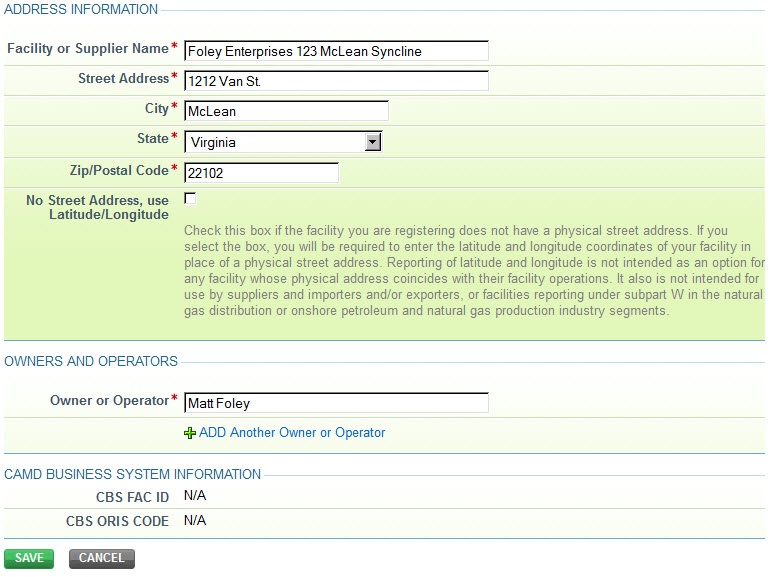Subpart W Facility Registration
- Overview of Facility Registration
- Facility Naming Convention for Subpart W Reporters
- Co-located industry segments and dual purpose equipment
- Submitting Reports under a facility subpart and a supplier subpart
- Guidance for Subpart W (Oil and Natural Gas Systems) Reporters Completing Registration within e-GGRT (PDF) (1 pg, 16K)
- Guidance for Subpart W Reporters on "Facility Address" (PDF) (1pg, 25K)
Overview of Facility Registration
In order to submit a Notice of Intent (NOI) or a request to use Best Available Monitoring Methods (BAMM) under subpart W for a particular facility, that facility must be registered in the e-GGRT system. Registration is accomplished using the Certificate of Representation (COR) form which is available in the e-GGRT system and is unique for each facility. A completed COR form includes information on the facility such as the identification of the facility, the address, a list of the owner(s) or operator(s), and the identification of the designated representative (DR) for that facility. This COR form must be signed by either the Designated Representative or the Alternate Designated Representative. Below you will find a screen snap for the e-GGRT screen used to record COR Data.
Click this link to expand
Facility Naming Convention for Subpart W Reporters
The petroleum and natural gas systems source category of the Greenhouse Gas Reporting Rule (GGRP) covers 8 industry segments; Offshore petroleum and natural gas production, onshore petroleum and natural gas production, onshore natural gas processing, onshore natural gas transmissions compression, underground natural gas storage, liquefied natural gas (LNG) storage, LNG import and export equipment, and natural gas distribution. Two of these eight industry segments have a unique definition of facility that is specifically defined in subpart W, namely the onshore petroleum and natural gas production industry segment and the natural gas distribution industry segment.
For the onshore petroleum and natural gas production industry segment, reporters must name their facilities based on the Hydrocarbon basins as defined by the American Association of Petroleum Geologists (AAPG) Provinces Codes as incorporated by reference into the final rule for Subpart W (75 FR 74488). This document can also be accessed at the AAPG website. For example, an onshore petroleum and natural gas production facility should use the following convention to insure that facilities are named distinctly from other facilities operating in the same basin: Owner Name + Basin Code + Basin Name(for example, MLH Production Inc. 420 Fort Worth Syncline).
Similarly, the Natural gas distribution industry segment also has a unique definition of facility which requires a unique facility naming convention. For Natural gas distribution, reporters should use the name of their local distribution company (LDC), and append the state where that facility is located to the end of the facility name (for example, Bright Lights Energy Inc. Florida).
The remaining 6 subpart W industry segments; Offshore petroleum and natural gas production, onshore natural gas processing, onshore natural gas transmission compression, underground natural gas storage, liquefied natural gas (LNG) storage, and LNG import and export equipment are subject to the same facility definitions applied to other direct emitters (see FAQ 10 for further detail) and should name their facilities using the facility name associated with their main mailing address.
The following list demonstrates the facility naming conventions for each of subpart W’s industry segments:
Type of Subpart W Facility | Recommended Facility Name Format |
|---|---|
Offshore petroleum and | Use standard naming convention from General Provisions – 98.3(c)(1) |
Onshore petroleum and | Owner Name+ Basin Code + Basin Name |
Onshore natural gas processing | Use standard naming convention from General Provisions – 98.3(c)(1) |
Onshore natural gas | Use standard naming convention from General Provisions – 98.3(c)(1) |
Underground natural | Use standard naming convention from General Provisions – 98.3(c)(1) |
Liquefied natural gas | Use standard naming convention from General Provisions – 98.3(c)(1) |
LNG import and | Use standard naming convention from General Provisions – 98.3(c)(1) |
Natural gas distribution | Name of LDC + state where that facility is located. |
Co-located industry segments and dual purpose equipment
There may be cases where a facility may report under more than one industry segment under subpart W, except for onshore petroleum and natural gas production and natural gas distribution, which have unique facility definitions. For collocated industry segments, which cannot occur in the case of onshore petroleum and natural gas production and natural gas distribution due to the requirements in 98.231(a). Reporters must determine the industry segment for which the majority of emissions occur and report all equipment within that industry segment for which there is a method defined. EPA recognizes that some data may not be reported where the obvious industry segment (e.g. processing plant) has one or a few producing wells inside the facility fence and the processing plant owner/operator does not have enough production emissions in the basin surrounding the processing facility to meet the reporting threshold under onshore production. EPA concludes that such random missing data will not impact the overall inventory’s ability to inform policy. Where a piece of equipment serves a dual purpose, such as a transmission compressor operating part time as a gas storage compressor, the rule requires this piece of equipment to be reported under the majority use industry segment. EPA concluded that most of the potential dual-purpose equipment will have the same emissions reporting requirements in either industry segment, so reporting under only one majority use segment will avoid double counting.
Submitting Reports under a facility subpart and a supplier subpart
Reporters who are reporting under both a direct emitter subpart and a supplier of greenhouse gas subpart, as in the example of a reporter who submits under both subpart W as a natural gas distribution facility and also under subpart NN as a local distribution company, may opt to select a separate DR for the supplier even if the operation happens to be the same company or location. Please see FAQ 254 for further discussion.


